.
Lise Meitner
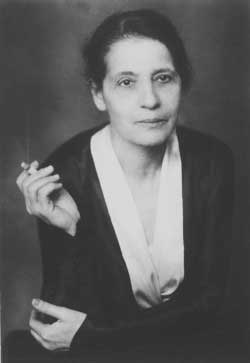
Lise Meitner (November 17[1], 1878 – October 27, 1968) was an Austrian-Swedish physicist who studied radioactivity and nuclear physics.
Biography
Born in Vienna, Austria, Lise Meitner was the third of eight children of Hedwig and Philipp Meitner, a freethinking liberal lawyer of Jewish origin, still remembered as a minor chess master. In later life she recalled their "unusual goodness" and the intellectual atmosphere of their house. With their help and private tuition she became one of the first to take advantage of recent relaxations in Austrian women has no access to further education. She persisted and entered the University of Vienna in 1901, studying physics under Ludwig Boltzmann. In 1905, she obtained her PhD in physics, the first woman to do so at that university. After she obtained her doctorate degree, she went to the Kaiser Wilhelm Institute in Berlin in 1907 to study with Max Planck and work with the chemist Otto Hahn. She collaborated with Hahn for 30 years, each of them leading a section in Berlin's Kaiser Wilhelm Institute for Chemistry. Hahn and Meitner collaborated closely, studying radioactivity with her knowledge of physics and his knowledge of chemistry.
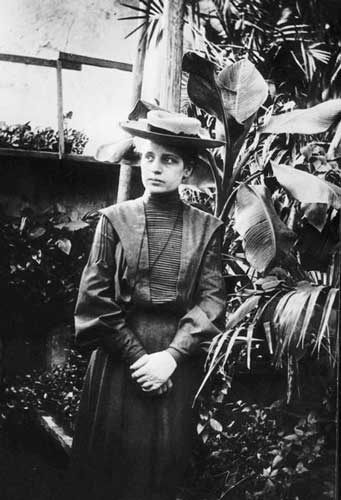
Lise Meitner ca. 1900.
In 1918, they discovered the first long-lived isotope of the element protactinium.
In 1923, she discovered the radiation-less transition known as the Auger effect, which is named for Pierre Victor Auger, a French scientist who independently discovered the effect in 1925.
In 1926, she became a full professor at the University of Berlin; she was the first woman in Germany to achieve this rank in any field of study.
With the discovery of the neutron in the early 1930s, speculation arose in the scientific community that it might be possible to create elements heavier than uranium (atomic number 92) in the laboratory. A scientific race began between Ernest Rutherford in Britain, Irene Joliot-Curie in France, Enrico Fermi in Italy, and the Meitner-Hahn team in Berlin. At the time, all concerned believed that this was abstract research for the probable honor of a Nobel prize. None suspected that this research would culminate in nuclear weapons.
After Nazi Germany annexed Austria in 1938, Dirk Coster persuaded Meitner that she should flee Germany for Sweden. Due to her Jewish heritage, she had been denied a current passport and was almost detained when a German guard asked to see her passport, which at that time was ten years out of date. The guard said nothing, however, and she crossed into the Netherlands.
She continued her work at Manne Siegbahn's institute in Stockholm, but with little support, partially due to Siegbahn's prejudice against women in science. Hahn and Meitner met clandestinely in Copenhagen in November to plan a new round of experiments; in this regard they subsequently exchanged a series of letters. The experiments which provided the evidence for nuclear fission were done at Hahn's laboratory in Berlin. This surviving correspondence indicates that Hahn believed nuclear fission was impossible until Meitner demonstrated to him that it had happened. She was the first person to realize that the nucleus of an atom could be split into smaller parts: uranium nuclei had split to form barium and krypton, accompanied by the ejection of several neutrons and a large amount of energy (the latter two products accounting for the loss in mass). A letter from Niels Bohr, commenting on the fact that the amount of energy released when he bombarded uranium atoms was far larger than had been predicted by calculations based on a non-fissile core, sparked the inspiration in December of 1938. Meitner's supporters claim that Meitner was the first to do the prediction calculations for a fissile nucleus, yet they have been unable to provide evidence to support Meitner. Hahn claimed that his chemistry had been solely responsible for the discovery.
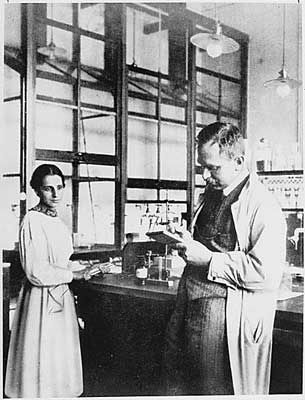
Meitner and Hahn working together at the Kaiser Wilhelm Institute
It was politically impossible for the exiled Meitner to publish jointly with Hahn in 1939. Hahn published the chemical findings in January 1939 and Meitner published the physical explanation the following month with her nephew, physicist Otto Robert Frisch, and named the process "nuclear fission". Meitner recognized the possibility for a chain reaction of enormous explosive potential. This report had an electrifying effect on the scientific community. Because this could be used as a weapon, and since the knowledge was in German hands, Leo Szilard, Edward Teller, and Eugene Wigner together jumped into action, persuading Albert Einstein, who had the celebrity, to write President Franklin D. Roosevelt a warning letter; this led directly to the establishment of the Manhattan Project. Meitner refused an offer to work on the project at Los Alamos, declaring "I will have nothing to do with a bomb!" (Sime, 305)
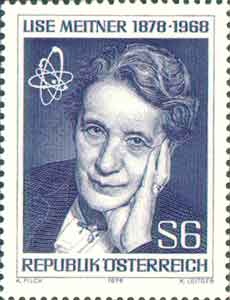
Lise Meitner Stamp , Austria
In 1944, Hahn received the Nobel Prize for Chemistry for the discovery of nuclear fission. In the opinion of many scientists, Meitner should have shared the prize. The omission may have been due to Hahn's public claims that the discovery was solely the work of chemistry; speculation also persists that — as Siegbahn was a Nobel committee member — his antipathy toward Meitner played a role as well. However, in 1966 Hahn, Fritz Straßmann and Meitner together were awarded the Enrico Fermi Award. On a visit to the USA in 1946 she received American press celebrity treatment as someone who had "left Germany with the bomb in my purse". She was honored as "Woman of the Year" by the National Women's Press Club (USA) in 1946, and received the Max Planck Medal of the German Physics Society in 1949.
Meitner moved to Cambridge, UK in 1960 and died there in 1968. Element 109 is named meitnerium in her honor.
Religion and ethnicity
Although born to and raised by a Jewish family, Ms. Meitner became a Lutheran as a young adult and remained so the rest of her life: she did not consider herself to be Jewish. This made no difference to the Nazis who persecuted her; however, she objected to accounts after the war that identified her as Jewish.
She became a Swedish citizen in 1949.
Further reading
- Frisch, Otto Robert (ed.) (1959). Trends in Atomic Physics: Essays Dedicated to Lise Meitner, Otto Hahn, Max von Laue on the Occasion of their 80th Birthday. New York: Interscience.
- Rife, Patricia (1999). Lise Meitner and the Dawn of the Nuclear Age. Birkhäuser.
- Lewin Sime, Ruth (1996). Lise Meitner: A Life in Physics. Berkeley: University of California Press. ISBN 0-520-08906-5.
- Yount, Lisa (1996). Twentieth Century Women Scientists. New York: Facts on File. ISBN 0-8160-3173-8.
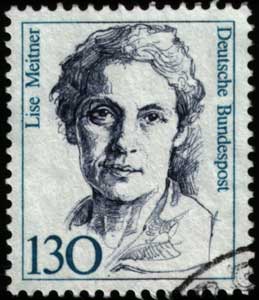
Lise Meitner Stamp, Germany, 5. May 1988
Retrieved from "http://en.wikipedia.org/"
All text is available under the terms of the GNU Free Documentation License

